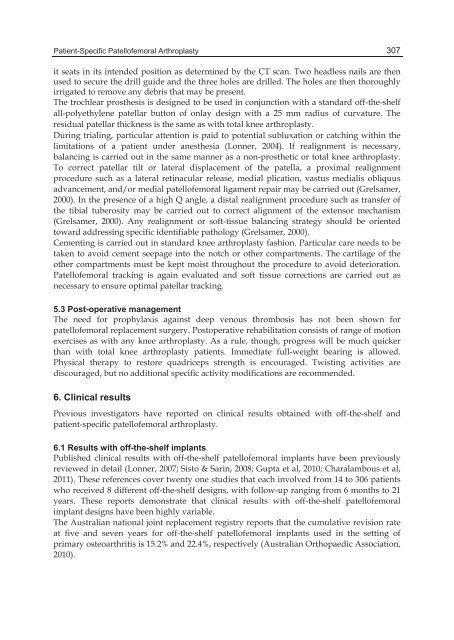RECENT ADVANCES IN HIP AND KNEE ARTHROPLASTY - Kinamed
RECENT ADVANCES IN HIP AND KNEE ARTHROPLASTY - Kinamed
RECENT ADVANCES IN HIP AND KNEE ARTHROPLASTY - Kinamed
You also want an ePaper? Increase the reach of your titles
YUMPU automatically turns print PDFs into web optimized ePapers that Google loves.
Patient-Specific Patellofemoral Arthroplasty<br />
it seats in its intended position as determined by the CT scan. Two headless nails are then<br />
used to secure the drill guide and the three holes are drilled. The holes are then thoroughly<br />
irrigated to remove any debris that may be present.<br />
The trochlear prosthesis is designed to be used in conjunction with a standard off-the-shelf<br />
all-polyethylene patellar button of onlay design with a 25 mm radius of curvature. The<br />
residual patellar thickness is the same as with total knee arthroplasty.<br />
During trialing, particular attention is paid to potential subluxation or catching within the<br />
limitations of a patient under anesthesia (Lonner, 2004). If realignment is necessary,<br />
balancing is carried out in the same manner as a non-prosthetic or total knee arthroplasty.<br />
To correct patellar tilt or lateral displacement of the patella, a proximal realignment<br />
procedure such as a lateral retinacular release, medial plication, vastus medialis obliquus<br />
advancement, and/or medial patellofemoral ligament repair may be carried out (Grelsamer,<br />
2000). In the presence of a high Q angle, a distal realignment procedure such as transfer of<br />
the tibial tuberosity may be carried out to correct alignment of the extensor mechanism<br />
(Grelsamer, 2000). Any realignment or soft-tissue balancing strategy should be oriented<br />
toward addressing specific identifiable pathology (Grelsamer, 2000).<br />
Cementing is carried out in standard knee arthroplasty fashion. Particular care needs to be<br />
taken to avoid cement seepage into the notch or other compartments. The cartilage of the<br />
other compartments must be kept moist throughout the procedure to avoid deterioration.<br />
Patellofemoral tracking is again evaluated and soft tissue corrections are carried out as<br />
necessary to ensure optimal patellar tracking.<br />
5.3 Post-operative management<br />
The need for prophylaxis against deep venous thrombosis has not been shown for<br />
patellofemoral replacement surgery. Postoperative rehabilitation consists of range of motion<br />
exercises as with any knee arthroplasty. As a rule, though, progress will be much quicker<br />
than with total knee arthroplasty patients. Immediate full-weight bearing is allowed.<br />
Physical therapy to restore quadriceps strength is encouraged. Twisting activities are<br />
discouraged, but no additional specific activity modifications are recommended.<br />
6. Clinical results<br />
Previous investigators have reported on clinical results obtained with off-the-shelf and<br />
patient-specific patellofemoral arthroplasty.<br />
6.1 Results with off-the-shelf implants<br />
Published clinical results with off-the-shelf patellofemoral implants have been previously<br />
reviewed in detail (Lonner, 2007; Sisto & Sarin, 2008; Gupta et al, 2010; Charalambous et al,<br />
2011). These references cover twenty one studies that each involved from 14 to 306 patients<br />
who received 8 different off-the-shelf designs, with follow-up ranging from 6 months to 21<br />
years. These reports demonstrate that clinical results with off-the-shelf patellofemoral<br />
implant designs have been highly variable.<br />
The Australian national joint replacement registry reports that the cumulative revision rate<br />
at five and seven years for off-the-shelf patellofemoral implants used in the setting of<br />
primary osteoarthritis is 15.2% and 22.4%, respectively (Australian Orthopaedic Association,<br />
2010).<br />
307


